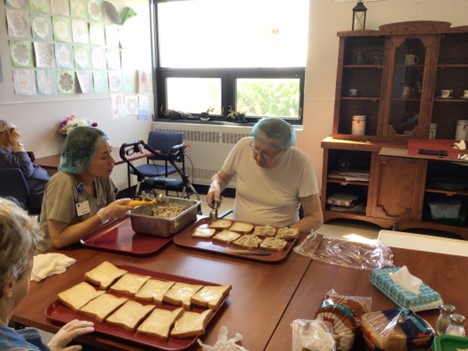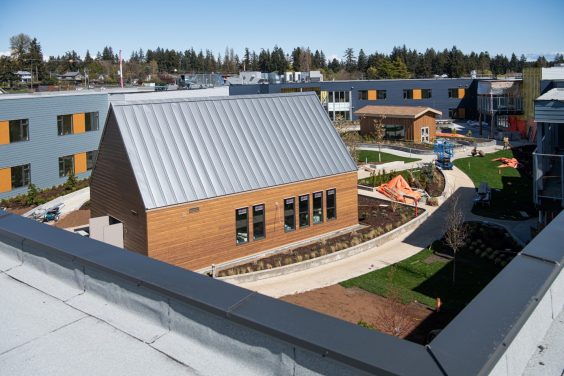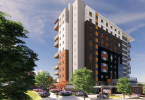A progressive, person-centred care model for seniors thatwill be the signature of a new long-term care village coming this summer to Comox is being piloted at another care home on Vancouver Island.
Through the pilot project, a made-in-BC care model that incorporates global best practices and is based on the concepts of a dementia village has been underway at The Views at St. Joseph’s (also in Comox) for over a year. The care model is called Home for Us (H4U). The pilot is previewing and refining in real time what future long-term care homes could be like in action and is proving the efficacy of this new care model.
The H4U care model offers long-term care residents emotional connections, autonomy, and personal fulfillment in their lives. They engage in ordinary activities like cooking, socializing, and having access to nature, ultimately building a sense of home, safety, and belonging.
Providence Living’s goal is to initially implement this care model throughout all existing and future builds of Providence long-term care homes across BC in collaboration with local health authorities. This includes Providence Living at The Views, the brand-new long-term care village that opens this summer in Comox.
Comox pilot takes flight
In January 2023, Providence Living launched the pilot project at The Views at St. Joseph’s for the purpose of testing and refining the new care model in a rural setting.
Not only does the pilot prepare staff for the move to Providence Living at The Views and the change in the care model they will be delivering, it’s giving them first-hand exposure to working within that model on a day-to-day basis.
A care village within a care home
The pilot simulates the concepts of a dementia village with the creation of two households of 10 residents each, a precursor to the 13 households of 12 residents each planned for the full-scale Providence Living at The Views. These pilot households, featuring mostly single rooms with individual washrooms, are designed to foster a home-like atmosphere. Here, new roles – for example, the multi-service worker that combines the food service and housekeeping roles – help residents become involved in the “stuff of life”, such as meal preparation and doing laundry within the households.
Visual and sensory enhancements
The pilot project households exhibit some elements of the new long-term care village. The households offer visual cues to cultivate a familiar, reassuring environment for residents with dementia. This includes the establishment of a household kitchen that they would likely remember from home. Homey touches have been added to different spaces – handmade quilts and throw pillows – as well as softer lighting in place of the harsh lighting often seen in more traditional long-term care homes that mimic a hospital-like setting.
How the new care model works – in a pilot or permanent setting
This new care model shifts from an institutional approach to a social relational and resident and family-centred approach.
The social relational model is different from traditional seniors’ care philosophies because incorporating this approach means always recognizing that aging adults flourish when they maintain their independence and social connections, and can participate in their desired and purposeful personal routines.
Within the institutional approach that is in most traditional long-term care homes, the rhythms and patterns of the day are directed by the institution’s priorities and are often focused around tasks. Within the social relational care model, the rhythms and patterns of the day are grounded in a person-centred approach and the residents drive the day. The main priority is to enable residents to live their best day possible.

Bidding adieu to institutionalized living
At its core, this care model transitions the focus from solely care to living and care, moving from scheduled routines that are largely influenced by institutional norms (such as when the kitchen has food ready) to flexible routines where the pace of the day is determined by the household members – in the same way most individuals decide how their own days will unfold.
Gone is the requirement for residents to be up and dressed for their 9 a.m. breakfast. Each long-term care resident sets the flow of their day – whether that’s sleeping until 10 a.m. or taking a stroll in the garden with friends. In the households, staff and residents are able to work together to make meals. The options are endless, and are aided by a compassionate team of staff.
Staff supporting residents’ choices
A social relational model ensures that people receive excellent medical and nursing care. The difference in the model is how that medical and nursing care is organized and delivered.
When residents have some agency over the patterns of their days, care team members work differently. Instead of coming to work and reporting at a facility like a hospital, staff honour the concept of home and understand that they work in the residents’ home. Instead of individually prioritizing completion of their tasks, teams work collaboratively, and assist residents in realizing their plans and goals for the day. Routines are adjusted to meet residents’ needs. Residents’ quality of life takes precedence over organizational and staff priorities. Decisions are made with residents instead of for residents.
“The pilot project gives us a critical preview of what a long-term care village is expected to be: a community within which there is no separation between staff, residents, and families, and where residents thrive,” said Mark Blandford, president and CEO of Providence Living.

A sneak peek of a long-term care village opening soon
Images and renderings of Providence Living at The Views are available on the Providence Living website.
More about Providence Living
In 2017, BC-based health care providers, Providence Health Care and St. Joseph’s General Hospital, established Providence Living to focus on significantly improving both the environment and experience of British Columbians living in long-term care homes. Providence Living is an independent, faith-based non-profit organization with its own board and management structure.





